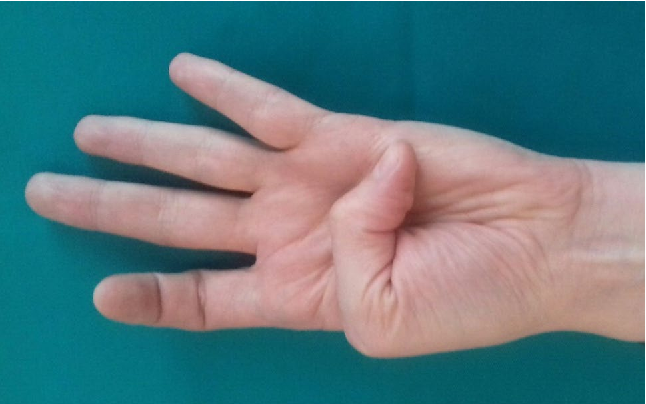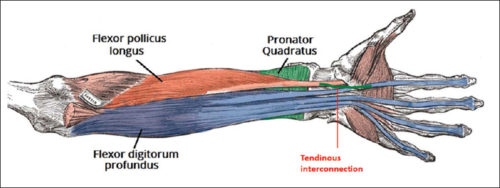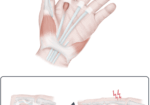By: Ammie Ingwaldson
Level 2 Fieldwork at a hand therapy clinic is a fast paced and continuous learning experience. The perfect example of this occurred last week while observing a therapist provide a client with their home CMC arthritis program. The therapist was educating the client on how to oppose their thumb to their small finger. While we watched them practice, she stated, “you have the Linburg sign!” She quickly turned to me and had me oppose my thumb to the base of my small finger, then confirmed that I had it as well. I began to become slightly concerned. We had not reviewed this sign or condition in school. I began to wonder if it was treatable and if it would affect me. My worries were put at bay when she then showed that she had it as well and provided an explanation of what it entailed.

Linburg Comstock syndrome is an anatomical anomaly connecting the tendons of flexor digitorum profundus (FDP) of the index finger and flexor policis longus (FPL) (Puroshothaman & Powers, 2008). This connection of tendons leads to involuntary flexion of the index finger at the distal interphalangeal (DIP) joint with flexion of the interphalangeal (IP) joint of the thumb. The incidence of this anomaly is 37%, with higher distribution of unilateral sign than bilateral.

In most cases Linburg-Comstock syndrome is asymptomatic, but it can present as pain in the distal forearm, wrist, or hand. Median nerve symptoms, similar to carpal tunnel, can also be present due to tendon inflammation, presence of additional tendons, or synovitis with in the carpal tunnel (Puroshothaman & Powers, 2008). Individuals with repetitive thumb and finger movements, such as musicians, are more susceptible to pain or carpal tunnel like symptoms. Surgical release of the connection of FPL and FDP can be performed to relieve symptoms (Old, Rajaratnam & Allen, 2010).
References
Old, O., Rajaratnam, V., & Allen, G. (2010). Traumatic correction of Linburg-Comstock anomaly: a case report. Annals of the Royal College of Surgeons of England, 92(4), W1–W3. doi:10.1308/147870810X12659688852031
Puroshothaman, P., & Powers, D. (2008) A simple diagnostic test for symptomatic Linburg-Comstock anomaly (Linburg-Comstock test). The Internet Journal of Hand Surgery, 2(2), 1-3.
2 Comments
Leave a Comment
More To Read
Mirror Therapy
Mirror therapy has many implications for therapy and can be used to treat many diagnoses that commonly involve the upper extremity. These include some of the Neuro Conditions we highlighted last week including, Stroke and Focal Hand Dystonia. Btw, you can download a mirror therapy exercises pdf here for free. How long should the patient…
Read MoreTaking Alpha-Lipoic Acid for 40 days after Carpal Tunnel Surgery can decrease the likelihood of developing Pillar Pain.
Filippo, B., Granchi, D., Roatti, G., Merlini, L., Sabattini, T., & Baldini, N. (2017). Alpha-lipoic acid after median nerve decompression at the carpal tunnel: A randomized controlled trial. The Journal of Hand Surgery, 4, 236–42. The Skinny – A double-blind, randomized controlled study was performed. Sixty-four patients were randomly assigned into two groups after median…
Read MoreHand Therapy as a New Grad or Student
Tips for Getting Prepared for hand therapy as a new grad or a Level II Fieldwork Everything you need to know in hand therapy starts with the upper extremity anatomy. Here is a quick checklist to review and hopefully help get you started in your new hand therapy setting. By: Tristany Hightower I suggest, as…
Read MoreWound Healing Complications in Diabetic Patients who have undergone a Carpal Tunnel or Trigger Finger Release
By: Amalia Garcia Gundlach, B. K., Robbins, C. B., Lawton, J. N., & Lien, J. R. (2021). Wound Healing Complications in Diabetic Patients Undergoing Carpal Tunnel and Trigger Finger Releases: A Retrospective Cohort Study. The Journal of Hand Surgery, S0363502321003014. https://doi.org/10.1016/j.jhsa.2021.05.009 The Skinny – carpal tunnel and diabetes In general, individuals with diabetes are more…
Read MoreSign-up to Get Updates Straight to Your Inbox!
Sign up with us and we will send you regular blog posts on everything hand therapy, notices every time we upload new videos and tutorials, along with handout, protocols, and other useful information.







I love that great fun fact with a quick explanation, great visual representation of the UE possible problems, and treatment options that are available.
Thanks.
I have this issue but not just one or two fingers is every finger in both hands. if i bend thumb even my little finger goes with it. Just wondering how rare it is for that to happen?